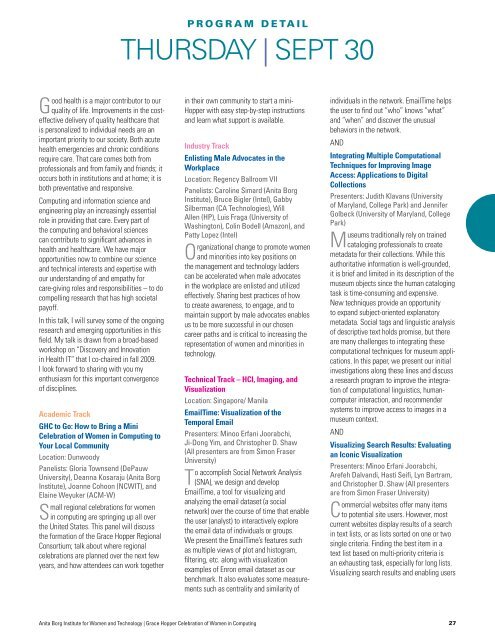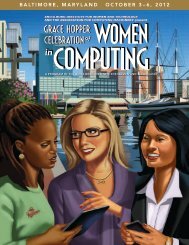ABI-ONE ghc program v14.indd - Grace Hopper Celebration of ...
ABI-ONE ghc program v14.indd - Grace Hopper Celebration of ...
ABI-ONE ghc program v14.indd - Grace Hopper Celebration of ...
You also want an ePaper? Increase the reach of your titles
YUMPU automatically turns print PDFs into web optimized ePapers that Google loves.
Good health is a major contributor to our<br />
quality <strong>of</strong> life. Improvements in the costeffective<br />
delivery <strong>of</strong> quality healthcare that<br />
is personalized to individual needs are an<br />
important priority to our society. Both acute<br />
health emergencies and chronic conditions<br />
require care. That care comes both from<br />
pr<strong>of</strong>essionals and from family and friends; it<br />
occurs both in institutions and at home; it is<br />
both preventative and responsive.<br />
Computing and information science and<br />
engineering play an increasingly essential<br />
role in providing that care. Every part <strong>of</strong><br />
the computing and behavioral sciences<br />
can contribute to significant advances in<br />
health and healthcare. We have major<br />
opportunities now to combine our science<br />
and technical interests and expertise with<br />
our understanding <strong>of</strong> and empathy for<br />
care-giving roles and responsibilities – to do<br />
compelling research that has high societal<br />
pay<strong>of</strong>f.<br />
In this talk, I will survey some <strong>of</strong> the ongoing<br />
research and emerging opportunities in this<br />
field. My talk is drawn from a broad-based<br />
workshop on “Discovery and Innovation<br />
in Health IT” that I co-chaired in fall 2009.<br />
I look forward to sharing with you my<br />
enthusiasm for this important convergence<br />
<strong>of</strong> disciplines.<br />
Academic Track<br />
GHC to Go: How to Bring a Mini<br />
<strong>Celebration</strong> <strong>of</strong> Women in Computing to<br />
Your Local Community<br />
Location: Dunwoody<br />
Panelists: Gloria Townsend (DePauw<br />
University), Deanna Kosaraju (Anita Borg<br />
Institute), Joanne Cohoon (NCWIT), and<br />
Elaine Weyuker (ACM-W)<br />
Small regional celebrations for women<br />
in computing are springing up all over<br />
the United States. This panel will discuss<br />
the formation <strong>of</strong> the <strong>Grace</strong> <strong>Hopper</strong> Regional<br />
Consortium; talk about where regional<br />
celebrations are planned over the next few<br />
years, and how attendees can work together<br />
p r O G r a m d e Ta i L<br />
THURSDAY | SEPT 30<br />
in their own community to start a mini-<br />
<strong>Hopper</strong> with easy step-by-step instructions<br />
and learn what support is available.<br />
Industry Track<br />
Enlisting Male Advocates in the<br />
Workplace<br />
Location: Regency Ballroom VII<br />
Panelists: Caroline Simard (Anita Borg<br />
Institute), Bruce Bigler (Intel), Gabby<br />
Silberman (CA Technologies), Will<br />
Allen (HP), Luis Fraga (University <strong>of</strong><br />
Washington), Colin Bodell (Amazon), and<br />
Patty Lopez (Intel)<br />
Organizational change to promote women<br />
and minorities into key positions on<br />
the management and technology ladders<br />
can be accelerated when male advocates<br />
in the workplace are enlisted and utilized<br />
effectively. Sharing best practices <strong>of</strong> how<br />
to create awareness, to engage, and to<br />
maintain support by male advocates enables<br />
us to be more successful in our chosen<br />
career paths and is critical to increasing the<br />
representation <strong>of</strong> women and minorities in<br />
technology.<br />
Technical Track – HCI, Imaging, and<br />
Visualization<br />
Location: Singapore/ Manila<br />
EmailTime: Visualization <strong>of</strong> the<br />
Temporal Email<br />
Presenters: Minoo Erfani Joorabchi,<br />
Ji-Dong Yim, and Christopher D. Shaw<br />
(All presenters are from Simon Fraser<br />
University)<br />
To accomplish Social Network Analysis<br />
(SNA), we design and develop<br />
EmailTime, a tool for visualizing and<br />
analyzing the email dataset (a social<br />
network) over the course <strong>of</strong> time that enable<br />
the user (analyst) to interactively explore<br />
the email data <strong>of</strong> individuals or groups.<br />
We present the EmailTime’s features such<br />
as multiple views <strong>of</strong> plot and histogram,<br />
filtering, etc. along with visualization<br />
examples <strong>of</strong> Enron email dataset as our<br />
benchmark. It also evaluates some measurements<br />
such as centrality and similarity <strong>of</strong><br />
individuals in the network. EmailTime helps<br />
the user to find out “who” knows “what”<br />
and “when” and discover the unusual<br />
behaviors in the network.<br />
AND<br />
Integrating Multiple Computational<br />
Techniques for Improving Image<br />
Access: Applications to Digital<br />
Collections<br />
Presenters: Judith Klavans (University<br />
<strong>of</strong> Maryland, College Park) and Jennifer<br />
Golbeck (University <strong>of</strong> Maryland, College<br />
Park)<br />
Museums traditionally rely on trained<br />
cataloging pr<strong>of</strong>essionals to create<br />
metadata for their collections. While this<br />
authoritative information is well-grounded,<br />
it is brief and limited in its description <strong>of</strong> the<br />
museum objects since the human cataloging<br />
task is time-consuming and expensive.<br />
New techniques provide an opportunity<br />
to expand subject-oriented explanatory<br />
metadata. Social tags and linguistic analysis<br />
<strong>of</strong> descriptive text holds promise, but there<br />
are many challenges to integrating these<br />
computational techniques for museum applications.<br />
In this paper, we present our initial<br />
investigations along these lines and discuss<br />
a research <strong>program</strong> to improve the integration<br />
<strong>of</strong> computational linguistics, humancomputer<br />
interaction, and recommender<br />
systems to improve access to images in a<br />
museum context.<br />
AND<br />
Visualizing Search Results: Evaluating<br />
an Iconic Visualization<br />
Presenters: Minoo Erfani Joorabchi,<br />
Arefeh Dalvandi, Hasti Seifi, Lyn Bartram,<br />
and Christopher D. Shaw (All presenters<br />
are from Simon Fraser University)<br />
Commercial websites <strong>of</strong>fer many items<br />
to potential site users. However, most<br />
current websites display results <strong>of</strong> a search<br />
in text lists, or as lists sorted on one or two<br />
single criteria. Finding the best item in a<br />
text list based on multi-priority criteria is<br />
an exhausting task, especially for long lists.<br />
Visualizing search results and enabling users<br />
Anita Borg Institute for Women and Technology | <strong>Grace</strong> <strong>Hopper</strong> <strong>Celebration</strong> <strong>of</strong> Women in Computing 27




